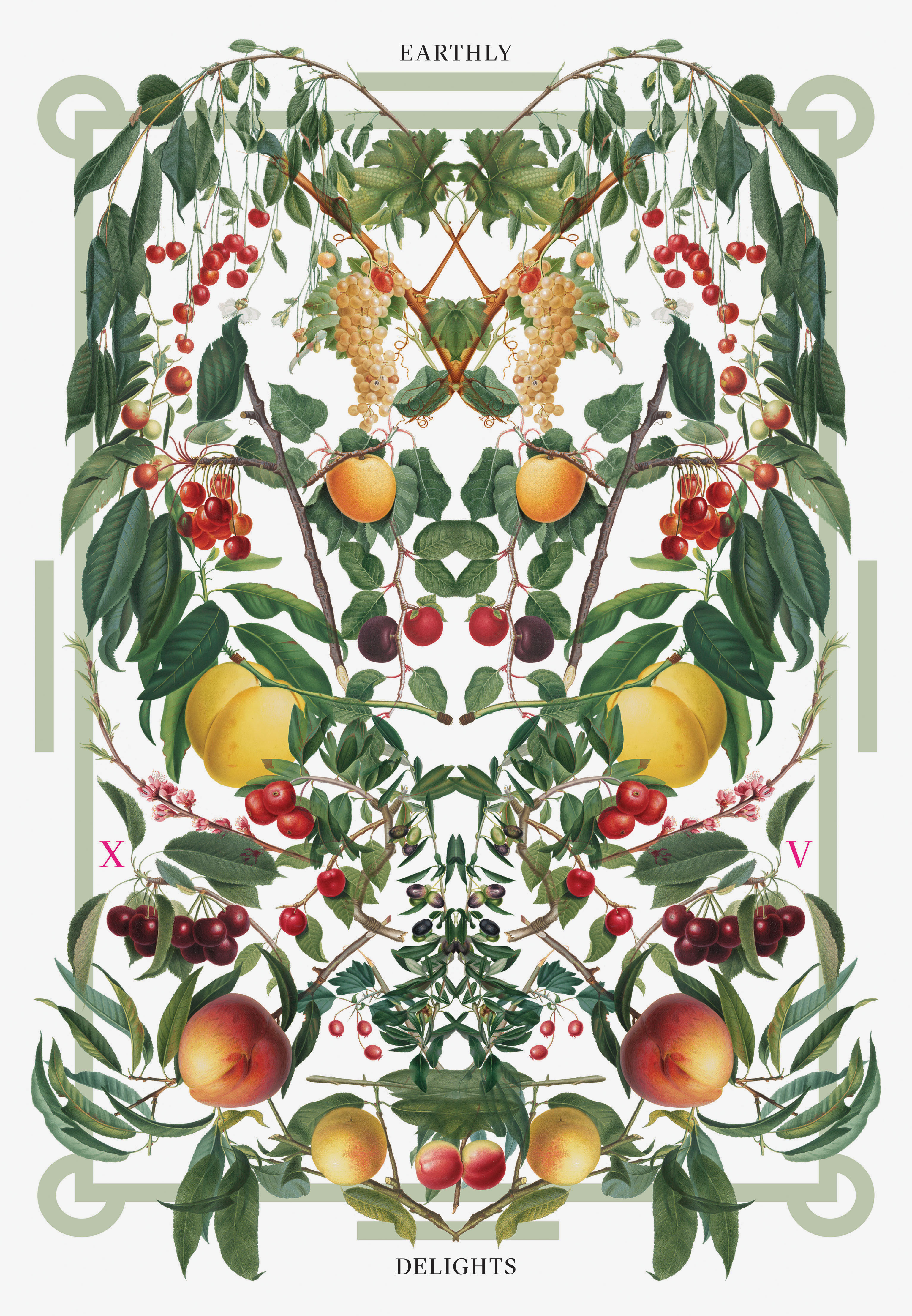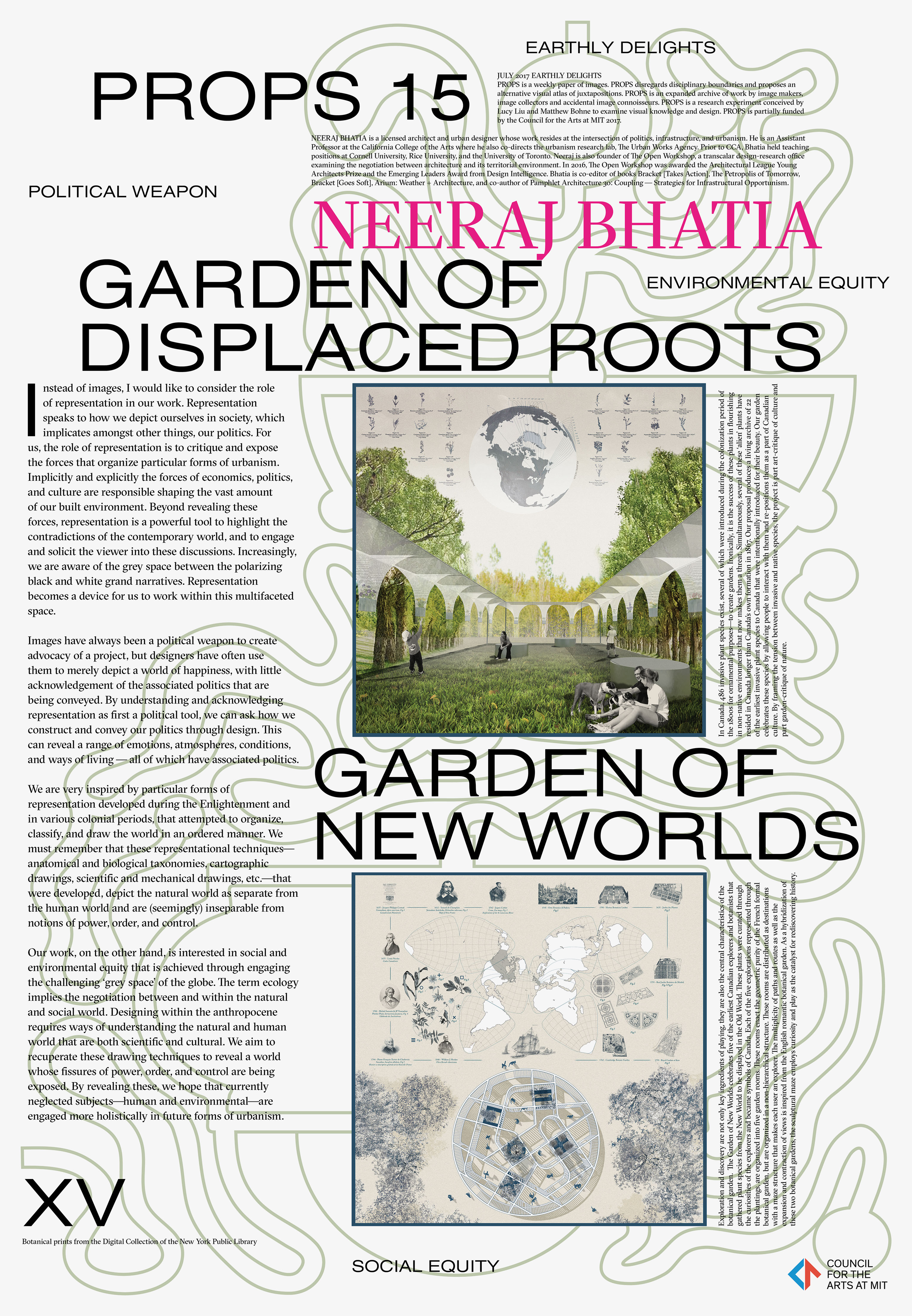

15 EARTHLY DELIGHTS
NEERAJ BHATIA︎︎︎
Instead of images, I would like to consider the role of representation in our work. Representation speaks to how we depict ourselves in society, which implicates amongst other things, our politics. For us, the role of representation is to critique and expose the forces that organize particular forms of urbanism. Implicitly and explicitly the forces of economics, politics, and culture are responsible shaping the vast amount of our built environment. Beyond revealing these forces, representation is a powerful tool to highlight the contradictions of the contemporary world, and to engage and solicit the viewer into these discussions. Increasingly, we are aware of the grey space between the polarizing black and white grand narratives. Representation becomes a device for us to work within this multifaceted space.
Images have always been a political weapon to create advocacy of a project, but designers have often use them to merely depict a world of happiness, with little acknowledgement of the associated politics that are being conveyed. By understanding and acknowledging representation as first a political tool, we can ask how we construct and convey our politics through design. This can reveal a range of emotions, atmospheres, conditions, and ways of living — all of which have associated politics.
We are very inspired by particular forms of representation developed during the Enlightenment and in various colonial periods, that attempted to organize, classify, and draw the world in an ordered manner. We must remember that these representational techniques—anatomical and biological taxonomies, cartographic drawings, scientific and mechanical drawings, etc.—that were developed, depict the natural world as separate from the human world and are (seemingly) inseparable from notions of power, order, and control.
Our work, on the other hand, is interested in social and environmental equity that is achieved through engaging the challenging ‘grey space’ of the globe. The term ecology implies the negotiation between and within the natural and social world. Designing within the anthropocene requires ways of understanding the natural and human world that are both scientific and cultural. We aim to recuperate these drawing techniques to reveal a world whose fissures of power, order, and control are being exposed. By revealing these, we hope that currently neglected subjects—human and environmental—are engaged more holistically in future forms of urbanism.
![]()
In Canada, 486 invasive plant species exist, several of which were introduced during the colonization period of the 1800s for ornamental purposes—to create gardens. Ironically, it is the success of these plants in flourishing in non-native environments that now makes them a threat. Simultaneously, several of these ‘alien’ plants have resided in Canada longer than Canada’s own formation in 1867. Our proposal produces a living archive of 22 of the earliest invasive plant species to Canada that were intentionally introduced for their beauty. Our garden celebrates these species by allowing people to interact with them and re-positions them as a part of Canadian culture. By framing the tension between invasive and native species, the project is part art-critique of culture and part garden-critique of nature.
![]()
Exploration and discovery are not only key ingredients of playing, they are also the central characteristics of the botanical garden. The Garden of New Worlds celebrates five of the earliest Canadian explorers and botanists that gathered plant species from the New World to be displayed in the Old World. These plants were curated through the curiosities of the explorers and became symbols of Canada. Each of the five explorations represented through the plantings, are organized into five garden rooms. These rooms enact the geometric purity of the French formal botanical garden, but are organized in a non-hierarchical structure. These rooms are distributed as destinations with a maze structure that makes each user an explorer. The multiplicity of paths and routes as well as the expansion and contraction of views is inspired from the English romantic botanical garden. As a hybridization of these two botanical gardens, the sculptural maze employs curiosity and play as the catalyst for rediscovering history.
Neeraj Bhatia︎︎︎ is a licensed architect and urban designer whose work resides at the intersection of politics, infrastructure, and urbanism. He is an Assistant Professor at the California College of the Arts where he also co-directs the urbanism research lab, The Urban Works Agency. Neeraj is founder of The Open Workshop, a transcalar design-research office examining the negotiation between architecture and its territorial environment. In 2016, The Open Workshop was awarded the Architectural League Young Architects Prize and the Emerging Leaders Award from Design Intelligence. Bhatia is co-editor of books Bracket [Takes Action], The Petropolis of Tomorrow, Bracket [Goes Soft], Arium: Weather + Architecture, and co-author of Pamphlet Architecture 30: Coupling — Strategies for Infrastructural Opportunism.
Instead of images, I would like to consider the role of representation in our work. Representation speaks to how we depict ourselves in society, which implicates amongst other things, our politics. For us, the role of representation is to critique and expose the forces that organize particular forms of urbanism. Implicitly and explicitly the forces of economics, politics, and culture are responsible shaping the vast amount of our built environment. Beyond revealing these forces, representation is a powerful tool to highlight the contradictions of the contemporary world, and to engage and solicit the viewer into these discussions. Increasingly, we are aware of the grey space between the polarizing black and white grand narratives. Representation becomes a device for us to work within this multifaceted space.
Images have always been a political weapon to create advocacy of a project, but designers have often use them to merely depict a world of happiness, with little acknowledgement of the associated politics that are being conveyed. By understanding and acknowledging representation as first a political tool, we can ask how we construct and convey our politics through design. This can reveal a range of emotions, atmospheres, conditions, and ways of living — all of which have associated politics.
We are very inspired by particular forms of representation developed during the Enlightenment and in various colonial periods, that attempted to organize, classify, and draw the world in an ordered manner. We must remember that these representational techniques—anatomical and biological taxonomies, cartographic drawings, scientific and mechanical drawings, etc.—that were developed, depict the natural world as separate from the human world and are (seemingly) inseparable from notions of power, order, and control.
Our work, on the other hand, is interested in social and environmental equity that is achieved through engaging the challenging ‘grey space’ of the globe. The term ecology implies the negotiation between and within the natural and social world. Designing within the anthropocene requires ways of understanding the natural and human world that are both scientific and cultural. We aim to recuperate these drawing techniques to reveal a world whose fissures of power, order, and control are being exposed. By revealing these, we hope that currently neglected subjects—human and environmental—are engaged more holistically in future forms of urbanism.
Garden of Displaced Roots

In Canada, 486 invasive plant species exist, several of which were introduced during the colonization period of the 1800s for ornamental purposes—to create gardens. Ironically, it is the success of these plants in flourishing in non-native environments that now makes them a threat. Simultaneously, several of these ‘alien’ plants have resided in Canada longer than Canada’s own formation in 1867. Our proposal produces a living archive of 22 of the earliest invasive plant species to Canada that were intentionally introduced for their beauty. Our garden celebrates these species by allowing people to interact with them and re-positions them as a part of Canadian culture. By framing the tension between invasive and native species, the project is part art-critique of culture and part garden-critique of nature.
Garden of New Worlds

Exploration and discovery are not only key ingredients of playing, they are also the central characteristics of the botanical garden. The Garden of New Worlds celebrates five of the earliest Canadian explorers and botanists that gathered plant species from the New World to be displayed in the Old World. These plants were curated through the curiosities of the explorers and became symbols of Canada. Each of the five explorations represented through the plantings, are organized into five garden rooms. These rooms enact the geometric purity of the French formal botanical garden, but are organized in a non-hierarchical structure. These rooms are distributed as destinations with a maze structure that makes each user an explorer. The multiplicity of paths and routes as well as the expansion and contraction of views is inspired from the English romantic botanical garden. As a hybridization of these two botanical gardens, the sculptural maze employs curiosity and play as the catalyst for rediscovering history.
Neeraj Bhatia︎︎︎ is a licensed architect and urban designer whose work resides at the intersection of politics, infrastructure, and urbanism. He is an Assistant Professor at the California College of the Arts where he also co-directs the urbanism research lab, The Urban Works Agency. Neeraj is founder of The Open Workshop, a transcalar design-research office examining the negotiation between architecture and its territorial environment. In 2016, The Open Workshop was awarded the Architectural League Young Architects Prize and the Emerging Leaders Award from Design Intelligence. Bhatia is co-editor of books Bracket [Takes Action], The Petropolis of Tomorrow, Bracket [Goes Soft], Arium: Weather + Architecture, and co-author of Pamphlet Architecture 30: Coupling — Strategies for Infrastructural Opportunism.